Home
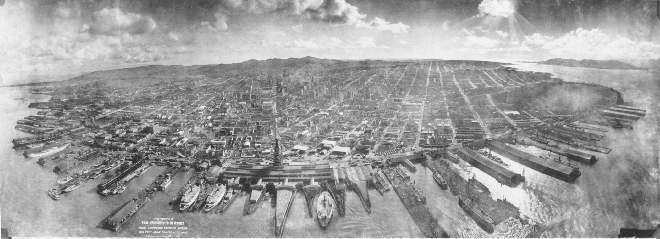
'SAN FRANCISCO IN RUINS'
is the title of this world-famous photograph. George Lawrence's
panorama camera produced a mammoth negative of 18 x 48 inches and
was raised 2,OOO feet over the bay by
his "Captive Airship," or kite train. Even
in this reduction it is possible to see that
block after block of the city was burned
flat and totally destroyed. Lawrence
sold copies of this photo to newspapers
and individuals and is reported to have
earned $15,OOO from these sales. (This
is the equivalent of approximately
$210,000 today.) LOC
|
George Lawrence
A Giant in Kite Aerial Photography
BY SIMON BAKER
Every student of kite history knows that George Lawrence,
the famous turn-of-the-century photographer, used kites in his aerial work
But two questions have been hanging unanswered in the brief spaces
given to Lawrence in kite literature.
- Did Lawrence use kites in taking his astonishing photograph of the 1906
San Francisco
post-earthquake fire? -- or did he use balloons?
- If Lawrence used kites, what was the size of the camera he lofted?
Was it his monster 900-pounder? Or just a moderately big one?
Simon Baker of East Carolina University has collected and analyzed
George Lawrence information for years. He has the answers.
|
My curiosity about George Raymond
Lawrence, the kite aerial photographer, is a
story going back more than 10 years and it
begins with my reading of Beaumont
Newhall's book Airborne Camera.
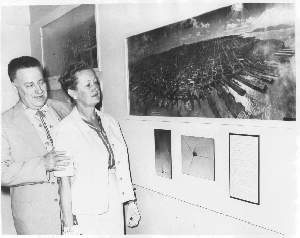
The fabulous photograph on display at the 1960 exhibition of the
work of George Lawrence at the
Chicago Historical Society. His son and
daughter-in-law are looking at an
original contact print. CHS
|
One of the most spectacular photographs
in the book is of San Francisco after the
great fire following the 1906 earthquake. I
had seen it before and assumed that the
camera was carried aloft by a balloon over
San Francisco Bay. Airplanes in 1906 were
not yet being used to make aerial photographs
this large; the negative was a staggering 18" x 48".
Newhall related that the camera was lifted
into the air by kites, but he had little to say
about how it was kept steady to make such
a sharp image or how much it actually
weighed. For answers to these and other
questions, I began a long research.
First I went to my university library and
found nothing on Lawrence. Later, on a
trip to Washington, D.C., I visited the Library
of Congress and discovered that its huge
catalog of books also had nothing by or
about him!
However, the Library of Congress people
did direct me to an obituary for George R.
Lawrence published in the New York Times
of December 16, 1938. This provided me
with a brief outline of the high points of his
life and career. The librarians also found a
pair of short articles in The Encyclopedia of
Photography entitled, "Biography of George
R. Lawrence" and "Kite and Balloon
Photography." They also suggested that I
visit the Prints and Photographs Collection
of the Library of Congress and examine its
catalog of holdings. They reasoned that,
since Lawrence was a commercial photographer,
he might have sent copies of his
products to the Library of Congress in order
to obtain copyrights on them.
The Prints and Photographs Collection
did and does indeed have many examples of
the work of George R. Lawrence. There are
photographs of big banquet groups, state legislatures
in session, and the Republican
National Conventions of 1904 and 1908. All
of these large interiors were captured on
oversized negatives with remarkable clarity
and detail. The means employed was a system
of electrically fired flashguns using an
improved flash powder invented by Lawrence.
There are other photographs showing
large crowds in attendance at horse races,
baseball and football games. In order to
make many of these outdoor photographs,
Lawrence carried his cameras aloft on guyed
ladders or a portable collapsible tower. This
tower was of his own invention and construction
reaching more than 200 feet into
the air.
Also in the collection are large photographs
of entire industrial plants, located
mostly in the Midwest. Of greatest interest
to me were the aerial photographs which are
remarkable for their size and clarity and the
fact that the cameras were lifted into the air
by what Lawrence called the "Captive
Airship" or kite train. My curiosity was
piqued and I had to know more about the
man and his method.
Having learned from his obituary that
Lawrence lived and worked in Chicago, I
sent letters to every museum and scientific
society in the city to learn who might have
information about this native son. The only
one responding positively was the Chicago
Historical Society. This organization owned
a number of original Lawrence photographs
and had exhibited them in a special show in
1960. Some time later, while on a visit to
Chicago, I went to the Historical Society
and examined their holdings.
At that time I also met a commercial
photographer named Thomas Yanul who
was working on a biography of George R.
Lawrence. Yanul very kindly shared his
information with me, and what I know of
the operation of the aerial panoramic camera
comes from him. He had personally
seen and photographed one of the few
surviving panoramic cameras.
I also learned of the existence of two
U.S. Navy reports on the operation of the
"Captive Airship." It seems that the U.S.
Army and Navy, at the prompting of
President Theodore Roosevelt, invited
Lawrence to demonstrate
his system in 1905. These
reports are housed at the
National Archives in
Washington, D.C. and I
obtained copies of them.
They represent the only
firsthand factual information
I have been able
to find about how the
kites were flown and how
the stabilizing system
worked.
The report of Naval
Lieutenant L H. Chandler
of May 22, 1905 (Record
Group 74) is very complete
and comes with illustrations
of the kites and
the steadying apparatus.
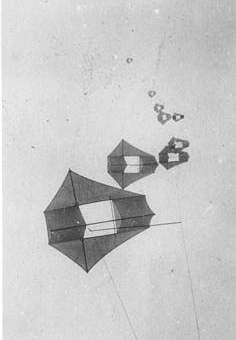
Above, a train of nine Conyne kites is sent aloft to raise a camera
which hangs suspended below the bottom kite. Each kite is attached
to the main line by its own short line and is prevented from becoming
entangled with it by a light bamboo rod. NARA
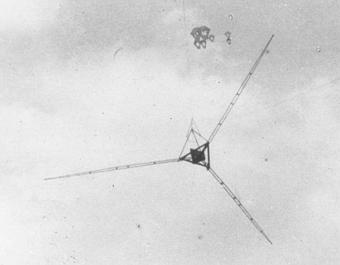
Above, the kite train and camera-steadying mechanism together make up
what Lawrence called his 'Captive Airship." Three equally spaced
15-foot-long booms radiate out from the cradle which holds the camera.
At the tip of each boom is a lead weight and a silk cord 12O
feet long is also attached. The other ends of the three cords are tied
together directly below the camera and a three-pound lead weight is attached
at that point (not visible in this view). In this case, a flat plate camera
is being flown rather than a panoramic camera. NARA
|
Lieutenant Chandler commented
on the weight of the latter by saying
that he could lift it with his left hand and
that it did not exceed 15 pounds. Further
testing at sea was recommended by Chandler.
George Lawrence, accompanied by two
assistants along with cameras, films, and
steadying apparatus, came on board the
U.S.S. Maine on August 25, 1905. Here a
team of officers, consisting of Lieutenant
Commanders W. H. G. Bullard, A. L Willard,
and Lieutenant J. H. Holden, observed and
worked with Lawrence until he left the ship
on October 7, 1905. Their report to the
Commander in Chief of the U.S. Atlantic
fleet (National Archives Record Group 74) is
dated January 12, 1906. They timed the
process from the ascent of the first kite until
the camera was landed back on deck as
averaging about one hour and a half. They
also described the panoramic camera being
used as having a 19-inch focal length, producing
a 20 by 48 inch plate, and weighing
49 pounds.
Lawrence, it seems, built about seven
versions of this panoramic camera. Some
were smaller and some were larger than the
one he used to demonstrate his system to
the military. He used wood and aluminum
in the construction of his aerial cameras
and the weight of 49 pounds is authoritative.
H. H. Slawson's article "Kite and Balloon
Photography" appearing in The Encyclopedia
of Photography speaks of "seven different
aerial cameras, which weighed from 400 to
1000 pounds." These numbers were picked
up by several other authors and appear in
the few articles written about Lawrence and
his methods.
There is some confusion here with a
huge camera designed by Lawrence in 1900
for the purpose of photographing a new
train of the Chicago and Alton Railway.
This camera required a crew of 15 to move
it around and set up, and weighed 900
pounds; 1400 pounds with the plate holder
in place. It produced a contact print of
eight by four-and-a-half feet and was obviously
never lifted into the air.
Lawrence was interested in obtaining
large panoramic views and he used ladders
and his portable tower for this purpose.
Soon he realized that he would have to get
higher to obtain views of really large areas so
he turned to hydrogen-filled balloons. On
June 21, 1901, while photographing the
Chicago stockyards from an altitude
of 900 feet, he was being
hauled down on completion of
the task. About 200 feet above
the ground, the network of ropes
holding the gas bag severed,
allowing it to escape, and
Lawrence fell. At about 30 feet
above the ground, his fall was
broken by a network of telephone
and telegraph wires. He hit the ground shaken
but not seriously hurt. A second balloon
mishap a month later in Minnesota seems
to have convinced Lawrence that he should
look for some other method of getting his
camera into the air.
Silas J. Conyne, a Chicago inventor,
patented a kite in 1902 for the purpose of
raising aloft advertising banners to attract
public attention. These kites appeared
promising to Lawrence as a means of raising
his cameras. He obtained the right to build
Conyne's kites and embarked on a period of
experimentation outside of Chicago in Zion,
Illinois. Sometime between 1902 and 1904,
he worked out the technique he was to use
successfully until he went out of the photography
business in 1910. He modified
and improved well-known techniques for
flying a train. A series of kites were attached
by short lines and prevented from becoming
entangled with the main kite line by the use
of bamboo spreaders. By these means he
was able to attain heights up to 2,000 feet
lifting his large but relatively light panoramic
cameras and the heavy piano wire cable
of several strands. Depending on the wind
velocity and the load to be lifted, Lawrence
could fly as many as 17 kites in a train;
however, five to 10 kites usually sufficed.
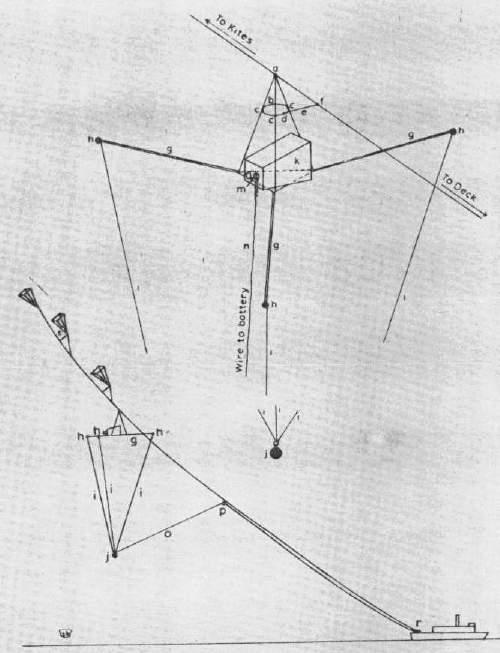
A diagrammatic representation of the
"Captive Airship" being flown from a ship.
The parts indicated are as follows: s, spreader
rod to keep kite clear of the main line; g,
the long booms extending 15 feet out from
the base of the camera cradle; h, small lead
weights of several ounces at the end of each
boom; i, 120-foot long silk cords; j, the three-pound
lead weight; o and p, a line and
pulley to keep j from dragging in the water
on launch and retrieval; and r, the winch.
Right inset, details of the steadying mechanism
showing the two-point attachment to
the kite line at a and f. The camera can be
pointed by making adjustments at b, c, d,
and e before it is sent aloft. A flat plate
camera, k, is mounted in the cradle in this
view. The camera shutter at m is operated
by electromagnets receiving current through
the wire, n, which is joined below this point
to the main piano-wire kite line, which has
an insulated copper wire as part of it. A battery
on the ground provides the necessary
current to operate the shutter. The other
parts of this steadying mechanism, g, h, i,
and j, are: 15-foot booms, lead weights of
several ounces, 12O-foot-long silk cords, and
a three-pound lead weight, respectively. This
mechanism prevents the camera from
turning and swinging like a pendulum in
spite of the movement of the kites.
Diagrams and details after the report by
Lieutenant L. H. Chandler,
U.S. National Archives.
|
From the sharpness of his aerial photographs,
it can be seen that Lawrence had
devised effective means for holding his cameras
steady while exposures were being made
in a windy environment. The mount hanging
suspended below the lowest kite in the
train allowed the camera to be pointed and
fixed in any direction before being sent
aloft. Once in the air, a system of booms,
lines, and lead weights prevented the camera
from excessive horizontal turning, while
at the same time dampening the tendency
of the camera to swing in the wind like a
pendulum.
Lawrence solved the problem of tripping
the shutter by incorporating an insulated
wire as part of the steel kite line, and
using it to carry an electric current up to
the camera to release the spring-driven
shutter.
For the purposes of aerial photography,
Lawrence modified an existing type of
panoramic camera which had a curved film
plane and a lens mounted in a horizontally
rotating barrel on vertical pivots. These
lens barrels were mounted below the horizontal
midline of the film plane, unlike
commercially available panoramic cameras
in which the lens was mounted opposite the
midline. This was done so that the camera,
which was usually level at the time of exposure,
would produce a view showing more
of the earth's surface and less of the sky. A
simple focal plane shutter, consisting of a
metal tube in the shape of a flattened cone,
was mounted directly behind the lens inside
the dark camera. As the lens turned through
160 degrees on its pivots, the image passed
through a vertical slit in the rear
of the flattened cone just in front
of the film. The length of the
exposure, for any part of the
film, was determined by the
width of the slit and the speed of
traverse at which the spring
mechanism drove the lens and
the flattened-cone focal plane shutter. In
order to reduce the comparatively abundant
sky light and allow for a longer exposure
of the darker land surface, he varied the
width of the slit. The image reached the
film upside down so he made the slit wider
on top to increase the length of exposure of
the darker land surface.
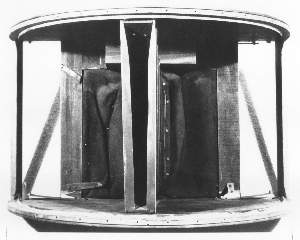
|
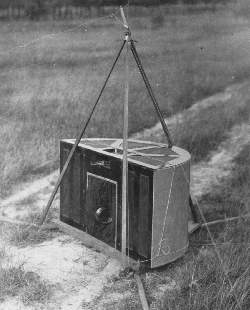
| |
Above, a panoramic camera with its
aluminum back removed to show the interior.
When loaded, the film plane is curved to conform
with the back. The focal plane shutter
consists of a flattened cone which is mounted
directly to the bock of the lens and swings
around with it. The image reaching the film
passes through the slit and that part of the
film in front of the wide portion of the slit
receives a longer exposure than that in front
of the narrow portion. YANUL
Right, an early version of the steadying
mechanism with a panoramic camera tied in
the cradle. The lens of the camera is cocked
to one side and held in place by an electrically
activated solenoid. To make an
exposure, a current from a battery is used to
activate the solenoid. Once released in this
fashion, a spring motor drives the lens
through a very wide arc of more than 12O
degrees. As the lens swings through this arc,
the flattened cone shutter mounted directly
behind it travels across the face of the film. CHS
|
|
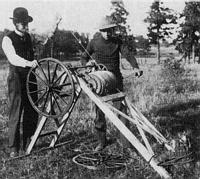
Above, George Lawrence, wearing the derby,
in the field with an assistant in Zion, Illinois
(north of Chicago) in about 1903, making
experiments with his "Captive Airship." When
the kite train flies, the pull is so strong that
it can only be controlled by the use of a
winch. In fact, it is often necessary to anchor
the winch as in this case, when it is tied to a
tree stump. CHS
|
In his photographic career, George R.
Lawrence was characterized by qualities of
imagination and inventiveness. He took
existing technological developments of his
day, modified them and combined them
in new ways to produce unique results.
Being a commercial photographer, he kept
the details of these techniques for himself.
When we compare his aerial photographs
with those of other kite photographers
who preceded him, it is clear that in
this line of technology the ultimate development
was achieved by Lawrence. His
photographs were unique when he made
them, and they compare favorably to similar
types of aerial photographs made
decades later -- even today -- by users of far
more sophisticated technological devices
than were available to him.
SOURCE ABBREVIATIONS:
CHS: Chicago Historical Society
LOC: Library of Congress
NARA: National Archives
YANUL: Collection of Thomas Yanul
This article first appeared in the Fall 1994 issue of Kitelines magazine
(Vol. 11, No. 1). Back issues are available at the
Kitelife.com website.








